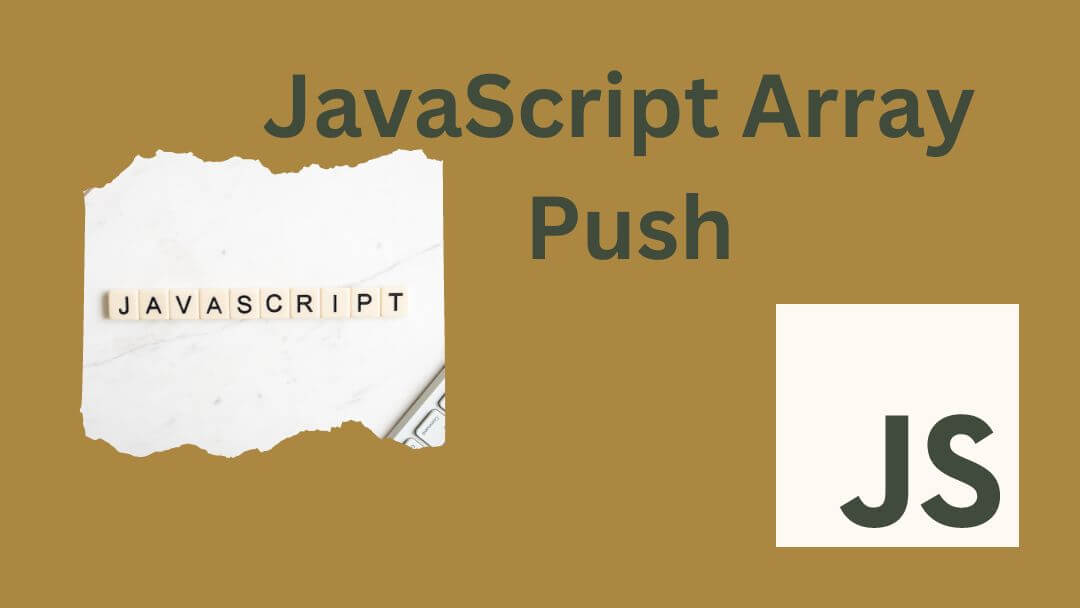Introduction To JavaScript Array Push
JavaScript Array Push: When it comes to JavaScript, the push method is an absolute game-changer in the world of arrays. This nifty function might look simple, but its capabilities work wonders for your coding endeavors.

Getting to Know JavaScript Arrays
Before we embark on our exploration of push, it’s essential that we establish a firm foundation by understanding JavaScript arrays.
At its core, an array is a structured data type that lets you store multiple values simultaneously – be they numbers, text strings, objects, or even other arrays!
The Magic of the JavaScript Array Push Method
What Exactly is push?
The push method, native to JavaScript, is tailor-made for arrays. Push is an invaluable function when you want to add elements onto the end of an array.
Push’s in-place operation enables it to modify the original array directly rather than create a new one, like other methods may.
The Syntax Breakdown
The code
array.push(item1, item2, …, itemX);
In simple terms, you feed the push method one or more items, and it dutifully adds them to the end of your array.
Unleashing the Potential of JavaScript Array Push
Adding Single Elements
Let’s start with the basics. You can use the push method to add a single element to an array. Here’s a quick example:
The code
const myArray = [1, 2, 3];
myArray.push(4); // This will stick 4 to the end of the array
Voila! Now, myArray becomes [1, 2, 3, 4].
Adding Multiple Elements
But where push truly shines is when you want to pile on multiple elements in one go. It’s as easy as providing multiple arguments:
The code
const myArray = [1, 2, 3];
myArray.push(4, 5, 6); // Adding 4, 5, and 6 to the end of the array
Result? myArray transforms into [1, 2, 3, 4, 5, 6].
A Handy Return Value
Here’s a neat tidbit: push isn’t just about adding stuff; it’s also about telling you how much stuff you’ve added. It returns the new length of your array, which can come in handy:
The code
const myArray = [1, 2, 3];
const newLength = myArray.push(4); // Adding 4 and getting the new length (4)
Now, newLength holds the value 4.
Practical Applications of JavaScript Array Push
Dynamic Lists in Action
Imagine you’re building a dynamic to-do list app. push can be your best friend here. It lets you add tasks as users input them, helping your list expand dynamically:
The code
const toDoList = [];
toDoList.push(“Finish report”);
toDoList.push(“Buy groceries”);
This approach allows your task list to grow as tasks pour in.
Queue it up, or Stack it in
In the realm of computer science, queues and stacks are essential data structures. You can mimic their behavior using JavaScript arrays and the push method, along with companions like shift and pop. This mixture can provide you all the power you need.
Keep an Eye Out for Potential Hiccups
While push is indeed a handy tool, a wise coder keeps a few considerations in mind:
- Handle with Care: Remember that push changes your original array. If you need to keep the original intact, make a copy before diving into push action.
- Performance Counts: In resource-intensive scenarios, consider alternative methods like unshift or concat, as they might be more efficient.
Wrapping it Up: JavaScript Array Push
In conclusion, mastering the push method in JavaScript arrays is a crucial skill for any developer. Its simplicity and efficiency make it a go-to for array manipulation, and by incorporating it into your coding arsenal, you can craft more dynamic and responsive web applications.
So, go ahead, embrace push, and take your JavaScript skills to the next level.
For more insights into JavaScript array manipulation and other advanced techniques, our website offers a wealth of resources. We’re here to help you push your coding boundaries.
Stay tuned for more in-depth JavaScript tutorials and expert tips.
Frequently asked questions
What is the primary purpose of the push method in JavaScript arrays? Push is a key function in JavaScript arrays that permits users to add one or more elements at the end of an array.
This dynamic component makes expanding an array easy.
Can you deliver an example of the push method to add a single part to an array?
Certainly! You can use the push method like this:
The code
const myArray = [1, 2, 3];
myArray.push(4); // This will add 4 to the end of the array
How does the push method handle adding multiple elements to an array simultaneously?
The push method excels at adding multiple elements in one go. You can provide multiple arguments, and it will add them all to the end of the array. For example:
The code
const myArray = [1, 2, 3];
myArray.push(4, 5, 6); // This adds 4, 5, and 6 to the end of the array
Is there any return value when using the push method in JavaScript arrays?
Yes, the push method returns the new length of the array after adding the elements. This is useful for tracking the size of your array. For instance:
The code
const myArray = [1, 2, 3];
const newLength = myArray.push(4); // Adding 4 and getting the new length (4)
Now, newLength will hold the value 4.
What are some considerations when using the push method in JavaScript arrays?
While push is a valuable tool, remember that it modifies the original array directly.
If you need to preserve the original array, make a copy of it before using push. Additionally, in performance-critical scenarios, consider alternative methods like unshift or concat for more efficiency.
